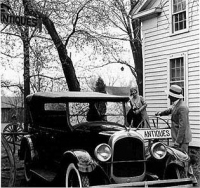The First Chrysler
In 1924 Chrysler became the last successful new car company start-up in the US for over 70 years. The company was founded by Walter P. Chrysler, who had left General Motors in 1920, and was designed by engineer Carl Breer (1883-1970).
Denied space in the 1924 auto show by the leading manufacturers, Chrysler introduced his new car in a nearby hotel lobby. The model featured improved 4-wheel hydraulic brakes, which first appeared on the 1921 Duesenberg, but were plagued with leakage problems. The new car was an instant success. Within a year, Chrysler was considered one of the "big three," along with Ford and GM, together building 80 per cent of all US cars.
In 1928, Chrysler Motors introduced the Plymouth, and established an Art and Color Department headed by industrial designer Herbert V. Henderson, following the lead of General Motors, who had established a similar department headed by Harley Earl the year before. But Henderson's group had little to do with body design.
In 1931, The Chrysler Building was built in New York, becoming the tallest building in the world for a few months before the completion of the Empire State Building.
Well-known body designer Raymond Dietrich (1894-1980) joined Chrysler as a consultant in 1932, becoming unofficial head of the Art and Color Department, then the official head from 1934 until 1940.
In 1934, the Chrysler Airflow, designed by chief engineer Carl Breer and his staff engineers Fred Zeder and Owen Skelton, introduced leading-edge aerodynamic styling, innovative weight distribution and unitized body construction. While the too-advanced design was a failure in the market, it had significant future influence in automotive design.
